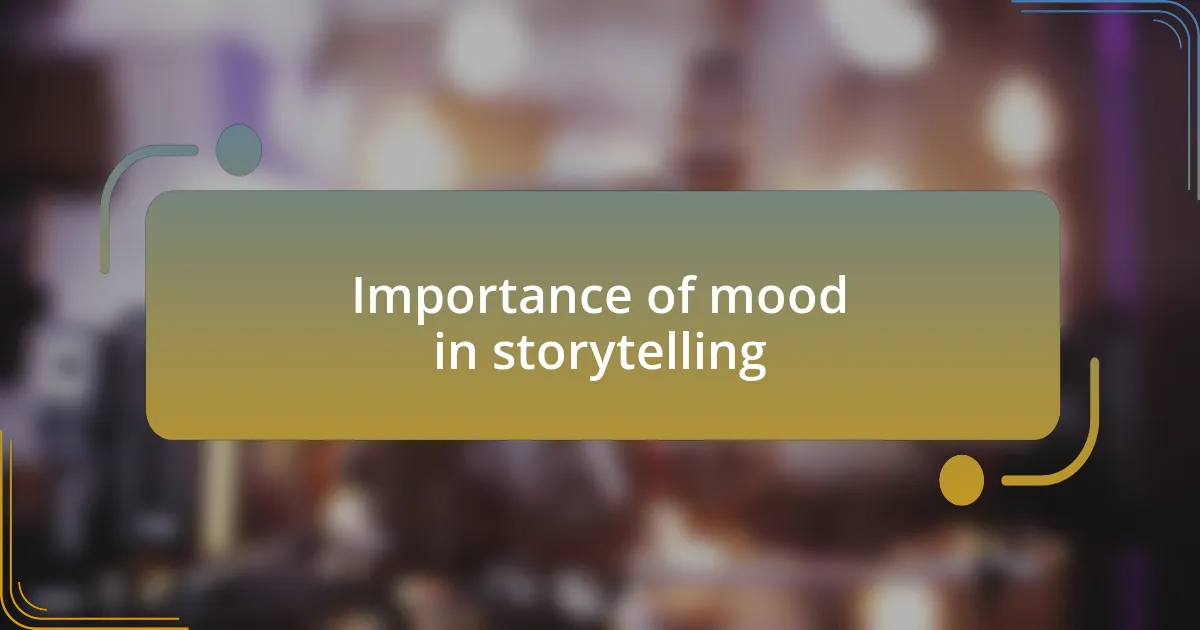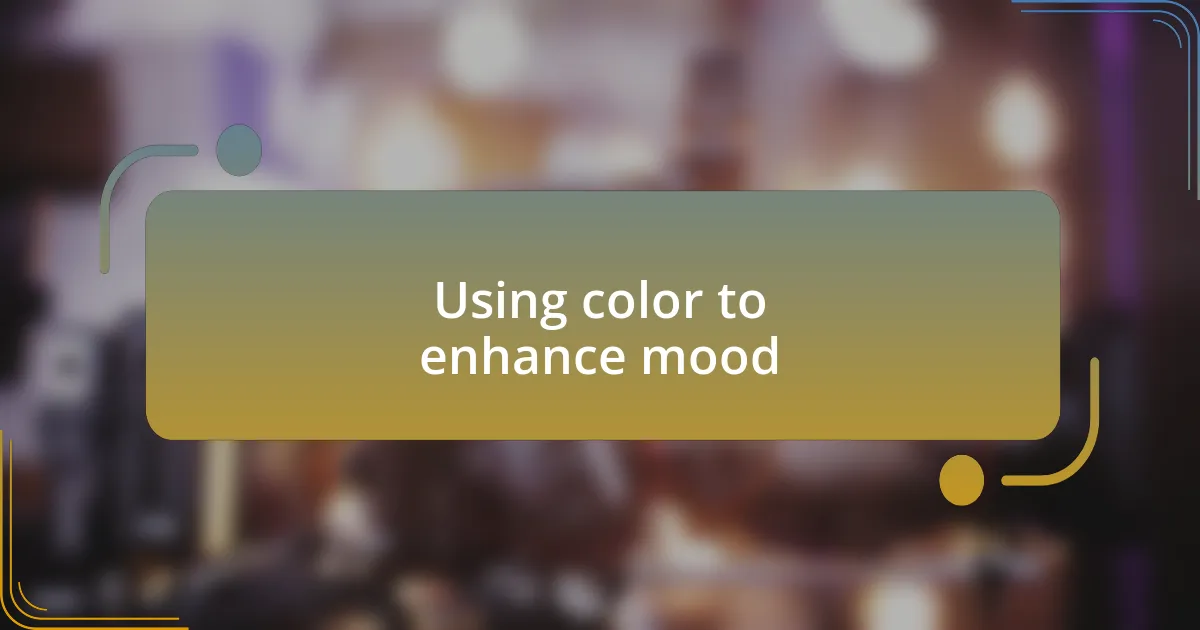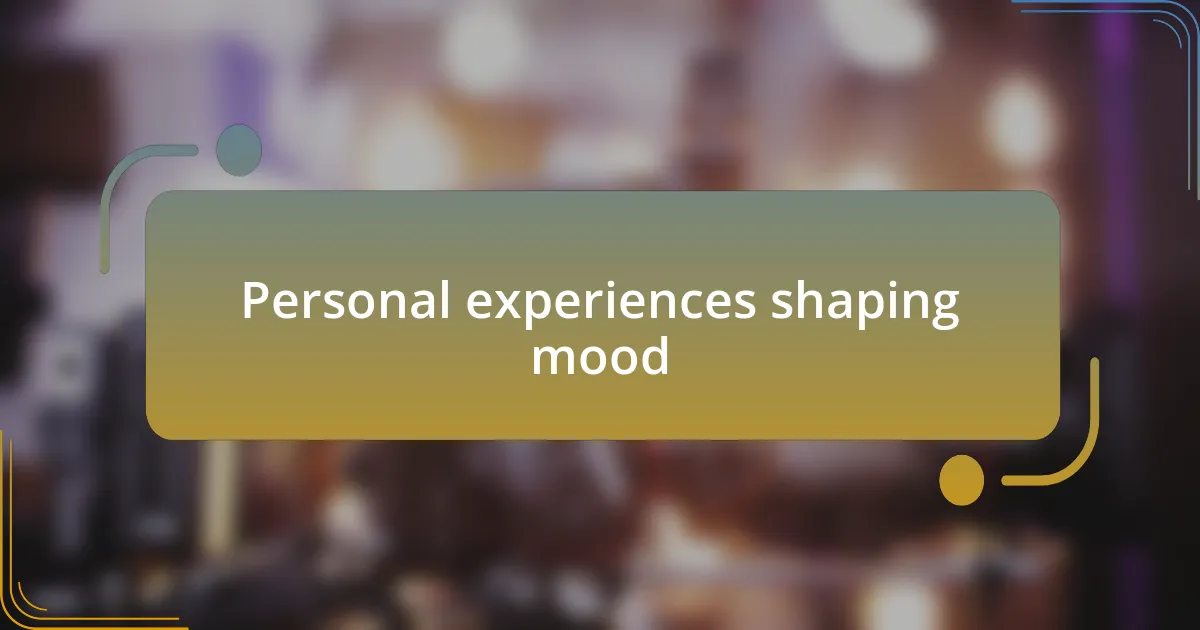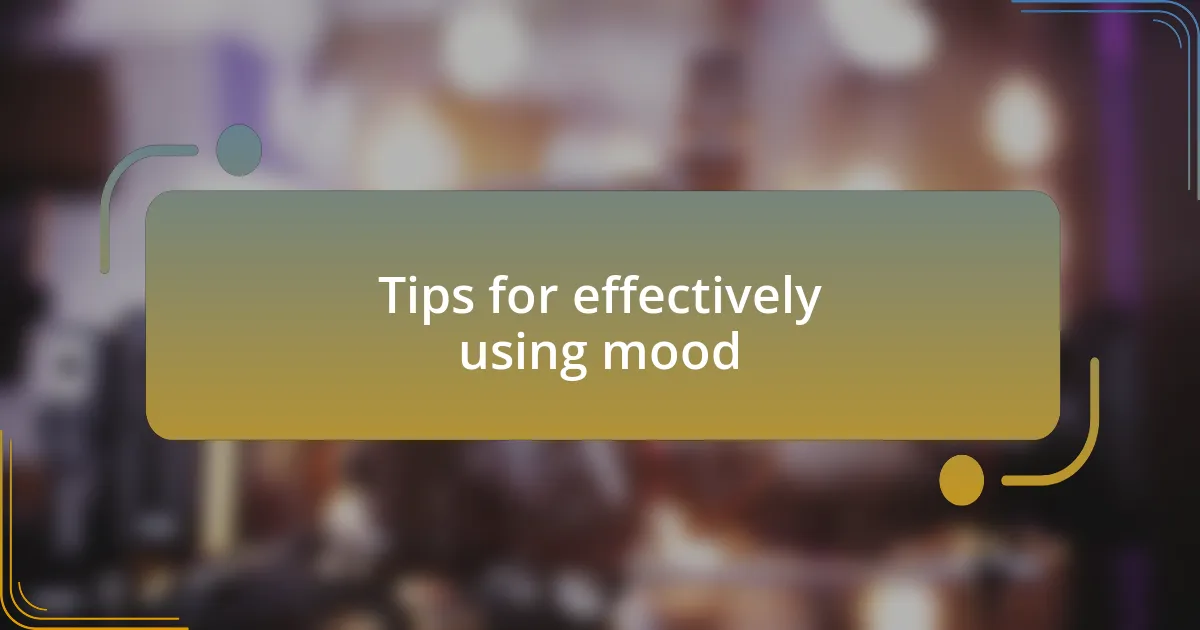Key takeaways:
- Mood in film is essential for shaping audience emotions and enhancing connection to characters, achieved through audio-visual elements like music, color, and lighting.
- Techniques such as strategic color palettes and sound design significantly influence the atmosphere, guiding viewer emotions and responses throughout the narrative.
- Personal experiences and introspection can inform creative choices in establishing mood, allowing filmmakers to translate their emotions into powerful visual storytelling.

Understanding mood in film
Mood in film is the emotional atmosphere that permeates a scene, deeply influencing how the audience feels about the story unfolding on screen. I’ve often found that a well-crafted mood can transform even the simplest scenes into something profoundly moving. For instance, during a recent project, I used soft lighting and a melancholic score to evoke a sense of nostalgia, and it was remarkable how it resonated with viewers.
Think about it: how can a scene’s mood dictate our connection to the characters? In my experience, the right mood makes the audience not just observers but actually participants in the emotional journey. I remember working on a tense thriller where the mood shifted dramatically between suspense and relief, keeping viewers on the edge of their seats—there’s a magic in that balance.
When you watch a film, consider how music, color palette, and pacing all work together to create mood. I once attended a screening of a beautifully shot film that used desaturated colors to enhance a somber mood. It struck me then how powerful visual and auditory elements intertwine to shape our emotional responses—creating a shared experience that can linger long after the credits roll.

Importance of mood in storytelling
Mood plays a crucial role in storytelling, as it can dramatically shift the audience’s emotional state. I recall a scene from an indie film I worked on, where we used shadows and confined spaces to create a feeling of claustrophobia. It was fascinating to see how the audience physically reacted—leaning in nervously during tense moments, fully absorbed in the characters’ plight.
Have you ever noticed how a sudden change in mood can alter the entire narrative? In a comedy I directed, we deliberately swung between light-hearted banter and unexpected emotional depth. This not only kept viewers engaged but also made the laughs hit harder, showing them that humor can coexist beautifully with more serious themes.
I’ve often found that a well-established mood can serve as the heartbeat of a story. Working on a film that highlighted the harsh realities of life, we opted for an almost muted style, visually mirroring the characters’ struggles. When I saw how audiences connected with the rawness of it all, it reinforced for me just how essential mood is—it invites viewers to feel and reflect, creating lasting impressions about what truly matters in life.

Techniques for setting mood
One effective technique for setting mood is through the use of color palettes. When I was working on a short film, we intentionally selected a warm color scheme for the romantic scenes and a cooler palette for the dramatic moments. The shift in colors not only influenced the characters’ emotions but also guided the audience’s feelings, almost like a visual cue that said, “Here’s where you should feel joy, and here’s where sorrow rests.”
Sound is another powerful tool that I’ve often leaned on to enhance mood. In one project, we employed a minimalistic score during an emotionally charged scene, allowing silence to amplify tension. The absence of sound can be just as impactful as its presence. Have you ever found yourself holding your breath during those quiet moments? It’s a reminder that sometimes less really is more.
Finally, using lighting strategically has been transformative in my filmmaking journey. I remember a particular scene where we dimmed the lights and introduced flickering sources, creating an atmosphere of uncertainty. That shift made the audience feel as though they were a part of the characters’ turmoil, enhancing their emotional investment. Isn’t it incredible how something as simple as light can alter not just what we see, but how we feel?

Using color to enhance mood
When I think about color’s role in film, I recall a project where we used vibrant reds and oranges to convey urgency and desire. The actors’ performances seemed more intense against that backdrop, almost that you could feel the heat radiating off the screen. Have you noticed how certain colors can evoke a visceral reaction, pulling you deeper into the narrative?
In another instance, during a tense thriller, I opted for green and murky tones. It set an eerie ambiance that made viewers uncomfortable, which is exactly what we aimed for. I often wonder how color subtly influences our subconscious—how a shade can creep into your thoughts and make your heart race without you even realizing it.
Additionally, I’ve experimented with desaturation in scenes meant to elicit nostalgia. By stripping away vibrancy, the visuals seemed to reflect the characters’ faded memories, stirring a sense of longing. It’s fascinating to see how we can manipulate perception through such simple choices, isn’t it? This blending of color and emotion truly transforms storytelling, making every frame a mood in itself.

Sound design for atmospheric scenes
Sound design plays a pivotal role in crafting atmospheric scenes that resonate with the audience. I vividly remember a moment while working on a horror short film, where we used whispers and ambient noises to build a sense of dread. The faint sound of creaking floorboards combined with the subtle rustle of leaves outside created an immersive experience that left viewers feeling on edge. It made me realize how sound can enhance visuals and draw viewers deeper into the film’s world.
In another project, during a serene, introspective scene, we layered soft piano melodies with gentle soundscapes of nature, like birds chirping and water flowing. This combination transformed a simple setting into a poignant moment that beautifully captured the character’s reflections. The harmony between these auditory elements amplified the emotional weight of the scene, making the viewers empathize with the character’s journey. Have you ever noticed how the sound of water can evoke tranquility even in the most chaotic stories?
What truly fascinates me is how silence can be an equally powerful component of sound design. During a dramatic confrontation, we intentionally introduced moments of silence before key dialogues, creating tension that was almost palpable. It made those lines more impactful, and I found that letting the audience sit with their anticipation heightens their emotional response. Isn’t it intriguing how the absence of sound can draw out feelings just as effectively as music or effects?

Personal experiences shaping mood
In my experience, personal moments often shape how I perceive and create mood in film. I recall a time I was watching a sunset while grappling with my own emotions. The colors seemed to reflect my inner turmoil, with vibrant oranges battling against muted grays. This experience taught me that using color palettes in film can resonate deeply with viewers, effectively translating personal emotions into visual storytelling. Have you ever found that a simple shade can evoke a specific feeling or memory for you?
During a particularly introspective phase in my life, I experimented with low-key lighting in a scene designed to depict solitude. As I manually adjusted the light to create stark contrasts, it mirrored my own feelings of isolation. This choice transformed an ordinary setting into a character’s emotional landscape. It’s fascinating how these deliberate decisions can turn a scene into a reflection of real-life struggles, don’t you think?
There was a moment while editing a love story when a beautiful image of a couple turned into something special through the power of nostalgia. I decided to overlay a grainy texture, reminiscent of old photographs, to evoke feelings of yearning and reminiscence. The subtle imperfections enhanced the mood, transforming a straightforward scene into a complex emotional experience. This taught me just how much personal experiences of love and loss can guide our choices in creating meaningful narratives.

Tips for effectively using mood
When it comes to effectively using mood, I’ve found that music can be a powerful tool. I remember a scene where I needed to convey a sense of urgency and tension. As I layered in a fast-paced score, the atmosphere shifted dramatically. It made me realize how important sound is in shaping emotions—can you think of a moment in a film where the music completely changed your perception of a scene?
Color grading is another aspect that has profoundly influenced my work. During a project set in a futuristic world, I chose cooler tones to instill a sense of detachment. The result was striking; it felt as though the audience was looking in on a life devoid of warmth and connection. Dimensionality in colors can drive home the feeling you’re trying to convey—what hues resonate with you emotionally?
I also believe that silence can sometimes be louder than any spoken word. In a documentary I was editing, a moment of pure stillness followed an emotional interview. The lack of sound created a weight that allowed viewers to feel the gravity of the subject’s experience. It made me reflect on the power of absence; have you ever noticed how a well-placed pause can leave a deeper impact than dialogue?